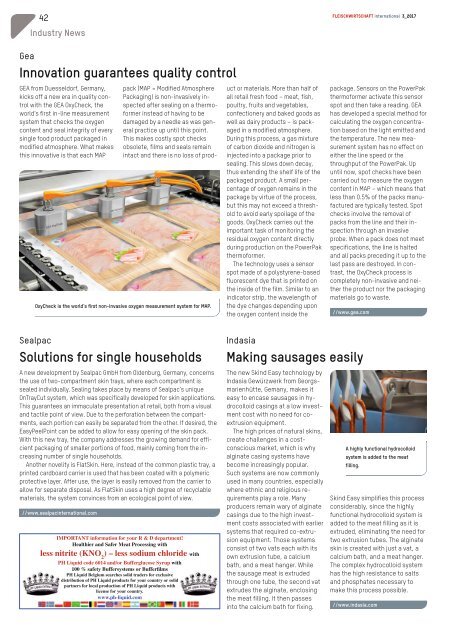FLEISCHWIRTSCHAFT international 3/2017
You also want an ePaper? Increase the reach of your titles
YUMPU automatically turns print PDFs into web optimized ePapers that Google loves.
42<br />
Fleischwirtschaft <strong>international</strong> 3_<strong>2017</strong><br />
Industry News<br />
Gea<br />
Innovation guarantees quality control<br />
GEA from Duesseldorf, Germany,<br />
kicks off anew era in quality control<br />
with the GEA OxyCheck, the<br />
world’sfirst in-line measurement<br />
system that checks the oxygen<br />
content and seal integrity of every<br />
single food product packaged in<br />
modified atmosphere. What makes<br />
this innovative is that each MAP<br />
OxyCheck is the world’sfirst non-invasive oxygen measurement system for MAP.<br />
pack (MAP =Modified Atmosphere<br />
Packaging) is non-invasivelyinspected<br />
after sealing on athermoformer<br />
instead of having to be<br />
damaged by aneedle as was general<br />
practice up until this point.<br />
This makes costlyspot checks<br />
obsolete, films and seals remain<br />
intact and there is no loss of product<br />
or materials. More than half of<br />
all retail fresh food –meat, fish,<br />
poultry, fruits and vegetables,<br />
confectionery and baked goods as<br />
well as dairy products –ispackaged<br />
in amodified atmosphere.<br />
During this process, agas mixture<br />
of carbon dioxide and nitrogen is<br />
injected into apackage prior to<br />
sealing. This slows down decay,<br />
thus extending the shelf life of the<br />
packaged product. Asmall percentage<br />
of oxygen remains in the<br />
package by virtue of the process,<br />
but this may not exceed athreshold<br />
to avoid earlyspoilage of the<br />
goods. OxyCheck carries out the<br />
important task of monitoring the<br />
residual oxygen content directly<br />
during production on the PowerPak<br />
thermoformer.<br />
The technology uses asensor<br />
spot made of apolystyrene-based<br />
fluorescent dye that is printed on<br />
the inside of the film. Similar to an<br />
indicator strip, the wavelength of<br />
the dye changes depending upon<br />
the oxygen content inside the<br />
package. Sensors on the PowerPak<br />
thermoformer activate this sensor<br />
spot and then take areading. GEA<br />
has developed aspecial method for<br />
calculating the oxygen concentration<br />
based on the light emitted and<br />
the temperature. The new measurement<br />
system has no effect on<br />
either the line speed or the<br />
throughput of the PowerPak. Up<br />
until now, spot checks have been<br />
carried out to measure the oxygen<br />
content in MAP –which means that<br />
less than 0.5% of the packs manufactured<br />
are typicallytested. Spot<br />
checks involve the removal of<br />
packs from the line and their inspection<br />
through an invasive<br />
probe. When apack does not meet<br />
specifications, the line is halted<br />
and all packs preceding it up to the<br />
last pass are destroyed. In contrast,<br />
the OxyCheck process is<br />
completelynon-invasive and neither<br />
the product nor the packaging<br />
materials go to waste.<br />
//www.gea.com<br />
Sealpac<br />
Solutions for single households<br />
Anew development by Sealpac GmbH from Oldenburg, Germany, concerns<br />
the use of two-compartment skin trays, where each compartment is<br />
sealed individually. Sealing takes place by means of Sealpac’sunique<br />
OnTrayCut system, which was specificallydeveloped for skin applications.<br />
This guarantees an immaculate presentation at retail, both from avisual<br />
and tactile point of view. Due to the perforation between the compartments,<br />
each portion can easilybeseparated from the other.Ifdesired, the<br />
EasyPeelPoint can be added to allow for easy opening of the skin pack.<br />
With this new tray, the company addresses the growing demand for efficient<br />
packaging of smaller portions of food, mainlycoming from the increasing<br />
number of single households.<br />
Another novelity is FlatSkin. Here, instead of the common plastic tray, a<br />
printed cardboard carrier is used that has been coated with apolymeric<br />
protective layer.After use, the layer is easilyremoved from the carrier to<br />
allow for separate disposal. As FlatSkin uses ahigh degree of recyclable<br />
materials, the system convinces from an ecological point of view.<br />
//www.sealpac<strong>international</strong>.com<br />
Indasia<br />
Making sausages easily<br />
The new Skind Easy technology by<br />
Indasia Gewürzwerk from Georgsmarienhütte,<br />
Gemany, makes it<br />
easy to encase sausages in hydrocolloid<br />
casings at alow investment<br />
cost with no need for coextrusion<br />
equipment.<br />
The high prices of natural skins,<br />
create challenges in acostconscious<br />
market, which is why<br />
alginate casing systems have<br />
become increasinglypopular.<br />
Such systems are now commonly<br />
used in many countries, especially<br />
where ethnic and religious requirements<br />
play arole. Many<br />
producers remain wary of alginate<br />
casings due to the high investment<br />
costs associated with earlier<br />
systems that required co-extrusion<br />
equipment. Those systems<br />
consist of two vats each with its<br />
own extrusion tube, acalcium<br />
bath, and ameat hanger.While<br />
the sausage meat is extruded<br />
through one tube, the second vat<br />
extrudes the alginate, enclosing<br />
the meat filling. It then passes<br />
into the calcium bath for fixing.<br />
Ahighlyfunctional hydrocolloid<br />
system is added to the meat<br />
filling.<br />
Skind Easy simplifies this process<br />
considerably, since the highly<br />
functional hydrocolloid system is<br />
added to the meat filling as it is<br />
extruded, eliminating the need for<br />
two extrusion tubes. The alginate<br />
skin is created with just avat, a<br />
calcium bath, and ameat hanger.<br />
The complex hydrocolloid system<br />
has the high resistance to salts<br />
and phosphates necessary to<br />
make this process possible.<br />
//www.indasia.com

















